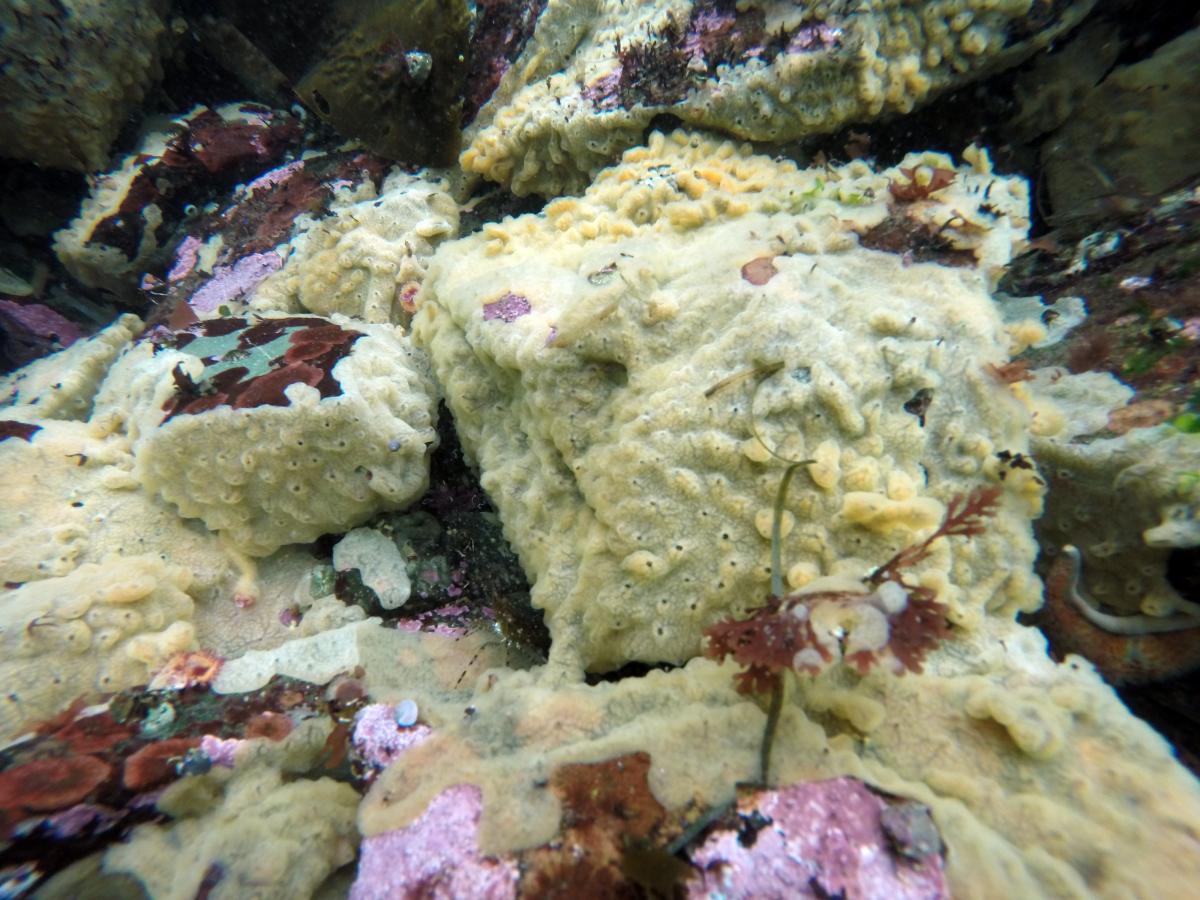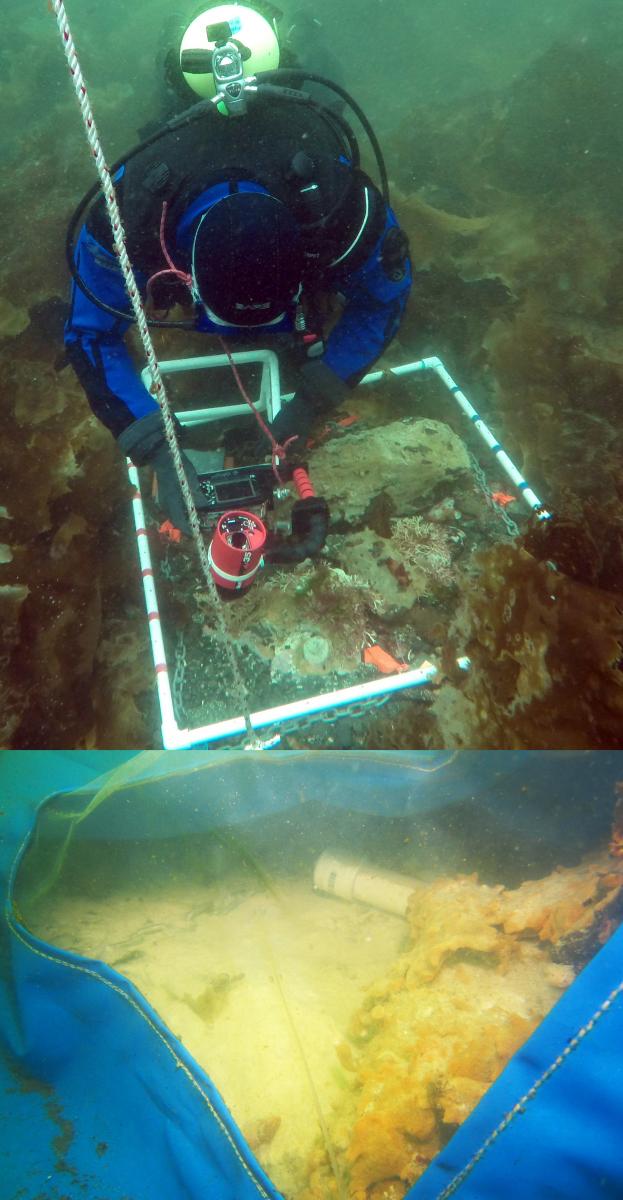Research ProjectEradication of Introduced Species
Investigating Eradication Treatments for Didemnum vexillum in Sitka, Alaska
Affiliated Labs
Project Goal
The project goal is to investigate potential techniques for eradication of a colonial tunicate (Didemnum vexillum) on the seafloor. Previous work looked at the feasibility of different treatments and current work will scale up those experiments to cover larger areas of the seafloor.
Description
Nonnative species management tries to prevent introductions from occurring through vector management and by reducing or removing introduced species that have already become established. Given the range of impacts caused by introduction, eradication or removal of a species can be a valuable tool for marine and coastal resource managers. Eradication has been used successfully in many other systems, for example the removal of black rats in Barrow, Australia and the removal of feral pigs Santa Catalina Island, CA, but removal has been underutilized in marine systems.

One nonnative species that has become a concern in Alaska is Didemnum vexillum (D. vex or rock vomit). D. vex is a colonial tunicate made up of many individuals, called zooids, that are compiled into a mat or tunic. It is originally from Japan but has been introduced around globe. Its ability to live in a variety of substrates and habitats, reproduce through fragmentation or “dripping”, and its fast growth rates make it a prolific invader. In many areas where it is invasive, D. vex can cover the seafloor smothering local species, for example, it covers over 200 km2 on Georges Bank off the coast of New England (Lengyel, Collie, and Valentine, 2009). In 2010, D. vex was found in Whiting Harbor in Sitka, AK as part of a volunteer scientist effort called BioBlitz (see related feature story). Given its detrimental effects in other areas, there is concern about how it might affect the Sitka Sound ecosystem and steps were taken to limit its spread. We have worked with our partners at the Alaska Department of Fish and Game to remove infested debris and develop an eradication plan.
Methodology
During summer 2015 we used custom-designed enclosures, like blue tents, to enclose areas of the seafloor and divers applied chlorine, lime, and salt treatments inside the enclosures. Divers used photographs and examined the seafloor by hand to measure the amount of D. vex present before and after treatments. After three weeks, we revisited the treated areas to see how the D. vex responded. Salt and chlorine treatments tested in 2015 removed 100% of the D. vex on the flat seafloor and chlorine was most effective on the sloped rocky causeway surrounding the harbor. Based on efficacy and logistics, chlorine was chosen as the most feasible for scaled-up treatments.
In summer 2018 we scaled up our trials to test the feasibility of our method on a larger spatial scale. We deployed turbidity curtains, which created large enclosed cylinders of the water column in both open and shore-bound spaces. Inside the tightly contained curtains we treated D. vex with chlorine and monitored the response of the invasive tunicate and its background community.


photographs treatment plot.
This will allow us to measure
the loss of D. vex cover.
Photo by M. Marraffini
Bottom: View inside a treatment
dome. Photo by: I. Davidson
Discoveries
We are analyzing preliminary results from the scaled up trials. Although 100% removal of D.vex was not achieved, there were very significant reductions in cover which may provide feasibility for a harbor wide removal campaign. Chemical eradication involves some loss of non-target (native) species but local plants and animals can re-colonize these areas. Since there are nearby populations of these species, they can regrow and resettle.
Future plans
While D. vex remains in an early stage of invasion in Alaska, we have an opportunity to manage it because of the relatively small scale of its current distribution. If it expands outside of Whiting Harbor and into Sitka Sound, that opportunity will be diminished. Our data shows that chlorine treatment can be used to remove it from the seafloor and, if combined with other techniques (e.g. manual removal), the tunicate may be suitable for a harbor-wide eradication attempt. Funding from the North Pacific Research Board for this project helps to determine how management can reduce the risk of further D. vex spread and curtail its expansion on the seafloor in Sitka. Results from the scaled-up treatments will be reported in 2019.
For more updates on our progress and tales from the field follow us on our blog.
Stories and Links
Collaborators
Alaska Department of Fish and Game
Publications
Cohen, C.S., McCann, L., Davis, T., Shaw, L. and Ruiz, G., 2011. Discovery and significance of the colonial tunicate Didemnum vexillum in Alaska. Aquatic Invasions, 6(3), pp.263-271.
McCann, L.D., Holzer, K.K., Davidson, I.C., Ashton, G.V., Chapman, M.D. and Ruiz, G.M., 2013. Promoting invasive species control and eradication in the sea: Options for managing the tunicate invader Didemnum vexillum in Sitka, Alaska. Marine pollution bulletin, 77(1), pp.165-171.
Contacts
Ian Davidson: davidsonI@si.edu
Katherine Newcomer: newcomerk@si.edu







